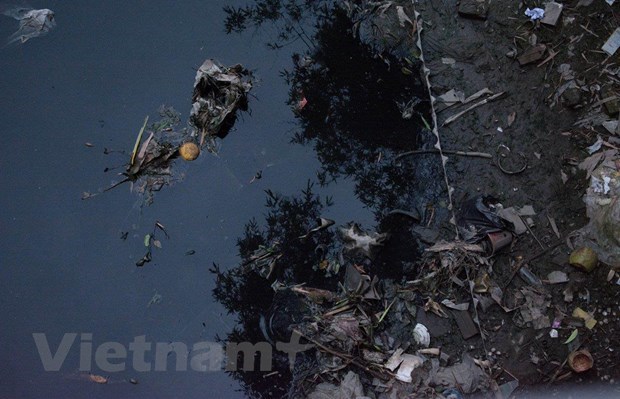Rivers shoulder burden of waste
The water quality in many river basins across the country are facing problems, and in some places, it has been seriously polluted, according to the 2018 national environment report.
 Water of the To Lich River in Hanoi has turned black (Photo: Vietnamplus)
Water of the To Lich River in Hanoi has turned black (Photo: Vietnamplus)Hanoi (VNA) – The water quality in many river basins across the country are facing problems, and in some places, it has been seriously polluted, according to the 2018 national environment report.
The Ministry of Natural Resources and Environment (MoNRE) said that pollution in river basins is complicated. The basins of the Cau and Nhue – Day rivers alone have to receive wastewater from about 6,000 sources, many of which are not treated.
Therefore, the top priority now is to soon create a mechanism for coordination among provinces in handling environmental issues so as to prevent widespread pollution.
Rivers under the burden of waste
The MoNRE’s report pointed out that in the Cau River basin, impact of socio-economic activities, especially operations of industrial parks, craft villages, processing zones and residential areas in the northern provinces of Bac Kan, Thai Nguyen, Vinh Phuc, Bac Giang, Bac Ninh and Hai Duong has severely polluted this basin.
As of July 2018, there were more than 4,000 waste sources in the Cau River basin, including 3,555 production and business facilities, 144 industrial parks and clusters, 238 medical establishments, and 140 craft villages. Most of the sources were located in Thai Nguyen (1,095), Bac Giang (799) and Bac Ninh (983).
Notably, wastewater from these sources was not treated but directly discharged into the environment, which has led to water quality degradation in the basin.
[Photos: Environment workers clean up To Lich river]
Preliminary data show that wastewater from production and business facilities accounted for some 68.88 of the total volume released into the Cau River basin, industrial parks and clusters 6.23 percent, craft villages 24.25 percent, and medical establishments 0.64 percent.
The MoNRE also surveyed 1,982 waste sources in the Nhue – Day river basin, which covers the northern provinces of Ha Nam, Nam Dinh, Ninh Binh and Hoa Binh, and part of Hanoi. They include 1,662 production and business establishments, 39 industrial parks and clusters, 137 medical stations, and 144 craft villages.
Currently, household wastewater makes up the largest proportion of all wastewater dumped into this basin, up to 65 percent, and most of it is also not treated but directly released into the Nhue and Day rivers.
 Water of many river basins is being seriously polluted (Photo: Vietnamplus)
Water of many river basins is being seriously polluted (Photo: Vietnamplus)Seeking ways to save “choked” rivers
MoNRE Deputy Minister Vo Tuan Nhan attributed water pollution in river basins to various causes, including waste sources and the spread of pollutants in water, and the main causes are wastewater from households, industrial and agricultural activities, craft villages and healthcare establishments, along with solid waste.
The ministry’s statistics show that as of 2017, the total wastewater discharged under licenses nationwide was about 100 million cub.m. per day, and household and industrial wastewater cover the largest proportions.
In agriculture, about 70 tonnes and over 40,000 litres of pesticide enter the environment each year, worsening the pollution of surface water and groundwater. Agricultural activities in the northern central and coastal central regions also have considerable impact on surface water.
Meanwhile, the volume of wastewater from medical facilities is not much but contains hazardous substances. The Ministry of Health said in 2018, the percentage of wastewater from hospitals treated in line with regulations reached 97.3 percent.
Besides, the large amount of solid waste dumped in wrong places has contaminated canals and rivers and even choked the flow of water. Unqualified dumping sites and waste treatment facilities are also major causes of water pollution.
[Japanese experts share experience in waste management]
Deputy Minister Nhan said challenges to the water environment in river basins have posed difficulties to the harmonisation of environmental protection and economic development.
Every year, river basin committees convene meetings to assess the situation and discuss solutions to protect the environment in their river basins. The provinces located in basins have also carried out action programmes to conserve the environment.
However, Nhan said, it is necessary to fine-tune policies and laws on protecting the environment in river basins and consolidate the system of State agencies in charge of water environment protection.
He also called on relevant parties to step up the planning of river basins and water exploitation and usage, increase inspection and examination of the adherence to relevant laws, and enhance cooperation with foreign partners in managing and protecting the water environment.
In particular, it is a must to thoroughly deal with pollution hot spots in river basins, strictly control waste sources, minimise pollution incidents, and soon build water environment monitoring stations in areas adjacent to neighbouring countries, the official added./.













